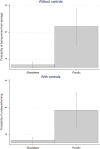Why are aid projects less effective in the Pacific?
- PMID: 35875260
- PMCID: PMC9291583
- DOI: 10.1111/dpr.12573
Why are aid projects less effective in the Pacific?
Abstract
Motivation: The Pacific is the world's most aid-dependent region, yet available data suggest aid projects are less effective on average in the Pacific than elsewhere in the developing world.
Purpose: This article examines the most likely explanations for lower aid project effectiveness in the Pacific. Explanations include poor governance, restricted levels of political freedom, poor economic performance, isolation, and small populations.
Methods and approach: Three approaches to causal mediation analysis are used to identify which explanatory variables best explain why aid projects are less effective in the Pacific. Aid project effectiveness data come from a multi-donor dataset of individual aid projects. Data on potential explanatory variables comes from a range of international datasets.
Findings: All three causal mediation approaches point to the isolation of many Pacific countries, alongside comparatively small populations, as being the main impediments to project effectiveness. These findings hold even with a suite of project traits being controlled for and within an analysis in which all the key country variables of interest are controlled for.
Policy implications: Project effectiveness in the Pacific appears to be primarily constrained by variables that cannot themselves be shifted (the region's countries cannot readily be made less remote or more populous). Improved project effectiveness in the Pacific will require donor practice to carefully adapt to the region's context. A structured process of donor learning will be needed.
Keywords: aid effectiveness; economic geography; the Pacific.
© 2021 The Authors. Development Policy Review published by John Wiley & Sons Ltd on behalf of Overseas Development Institute.
Figures


Similar articles
-
Australian aid projects: What works, where projects work and how Australia compares.Asia Pac Policy Stud. 2020 May;7(2):171-186. doi: 10.1002/app5.300. Epub 2020 May 11. Asia Pac Policy Stud. 2020. PMID: 32983522 Free PMC article.
-
The future of Cochrane Neonatal.Early Hum Dev. 2020 Nov;150:105191. doi: 10.1016/j.earlhumdev.2020.105191. Epub 2020 Sep 12. Early Hum Dev. 2020. PMID: 33036834
-
Aid fragmentation and volatility in the Pacific.Asia Pac Policy Stud. 2021 Jan;8(1):114-128. doi: 10.1002/app5.321. Epub 2021 May 4. Asia Pac Policy Stud. 2021. PMID: 34249360 Free PMC article.
-
The Minderoo-Monaco Commission on Plastics and Human Health.Ann Glob Health. 2023 Mar 21;89(1):23. doi: 10.5334/aogh.4056. eCollection 2023. Ann Glob Health. 2023. PMID: 36969097 Free PMC article. Review.
-
Challenge and response: HIV in Asia and the Pacific.Med J Aust. 1996 Nov 4;165(9):489-93. doi: 10.5694/j.1326-5377.1997.tb123234.x. Med J Aust. 1996. PMID: 8937370 Review.
Cited by
-
Research about eye health and eye health services in Pacific Island Countries and Territories: a scoping review.Lancet Reg Health West Pac. 2024 Jul 27;50:101152. doi: 10.1016/j.lanwpc.2024.101152. eCollection 2024 Sep. Lancet Reg Health West Pac. 2024. PMID: 39161741 Free PMC article.
-
A scoping review of health research in four Pacific Island countries and areas (Cook Islands, Fiji, Guam and Tonga) from 2014 to 2024.Lancet Reg Health West Pac. 2025 Jun 21;59:101602. doi: 10.1016/j.lanwpc.2025.101602. eCollection 2025 Jun. Lancet Reg Health West Pac. 2025. PMID: 40611950 Free PMC article. Review.
References
-
- Andrews, M. , Pritchett, L. , & Woolcock, M. (2013). Escaping capability traps through problem driven iterative adaptation (PDIA). World Development, 51, 234–244. 10.1016/j.worlddev.2013.05.011 - DOI
-
- Arndt, C. , Jones, S. , & Tarp, F. (2015). Assessing foreign aid’s long‐run contribution to growth and development. World Development, 69, 6–18. 10.1016/j.worlddev.2013.12.016 - DOI
-
- Asian Development Bank . (n.d.). Success rates database. https://www.adb.org/sites/default/files/evaluation‐document/214201/files...
-
- Bacchetta, M. , Beverelli, C. , Cadot, O. , Fugazza, M. , Grether, J.‐M. , Helble, M. , Nicita, A. , & Piermartini, R. (2010). A practical guide to trade policy analysis. World Trade Organization and UNCTAD. https://www.wto.org/english/res_e/publications_e/practical_guide12_e.htm
-
- Banerjee, A. , Karlan, D. , & Zinman, J. (2015). Six randomized evaluations of microcredit: Introduction and further steps. American Economic Journal: Applied Economics, 7(1), 1–22. 10.1257/app.20140287 - DOI
Associated data
LinkOut - more resources
Full Text Sources
